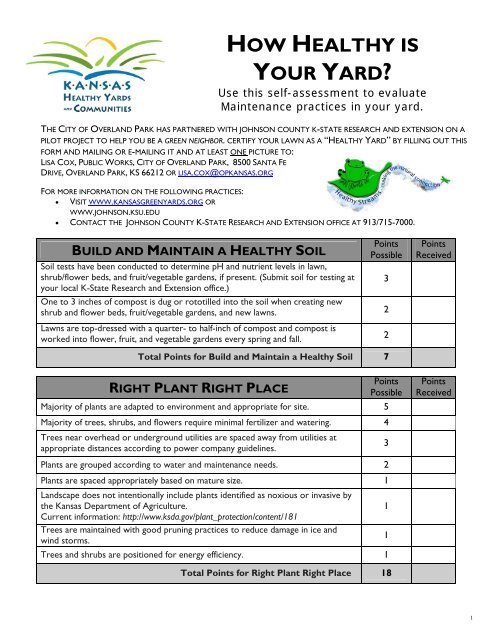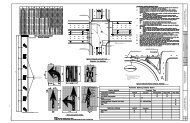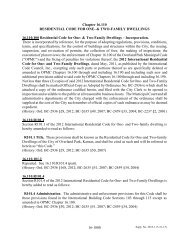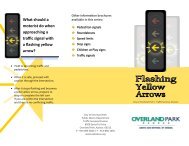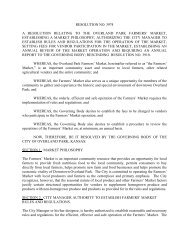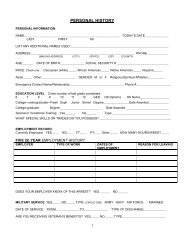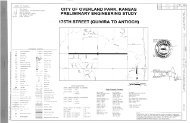certified - City of Overland Park
certified - City of Overland Park
certified - City of Overland Park
You also want an ePaper? Increase the reach of your titles
YUMPU automatically turns print PDFs into web optimized ePapers that Google loves.
HOW HEALTHY IS<br />
YOUR YARD?<br />
Use this self-assessment to evaluate<br />
Maintenance practices in your yard.<br />
THE CITY OF OVERLAND PARK HAS PARTNERED WITH JOHNSON COUNTY K-STATE RESEARCH AND EXTENSION ON A<br />
PILOT PROJECT TO HELP YOU BE A GREEN NEIGHBOR. CERTIFY YOUR LAWN AS A “HEALTHY YARD” BY FILLING OUT THIS<br />
FORM AND MAILING OR E-MAILING IT AND AT LEAST ONE PICTURE TO:<br />
LISA COX, PUBLIC WORKS, CITY OF OVERLAND PARK, 8500 SANTA FE<br />
DRIVE, OVERLAND PARK, KS 66212 OR LISA.COX@OPKANSAS.ORG<br />
FOR MORE INFORMATION ON THE FOLLOWING PRACTICES:<br />
VISIT WWW.KANSASGREENYARDS.ORG OR<br />
WWW.JOHNSON.KSU.EDU<br />
CONTACT THE JOHNSON COUNTY K-STATE RESEARCH AND EXTENSION OFFICE AT 913/715-7000.<br />
BUILD AND MAINTAIN A HEALTHY SOIL<br />
Soil tests have been conducted to determine pH and nutrient levels in lawn,<br />
shrub/flower beds, and fruit/vegetable gardens, if present. (Submit soil for testing at<br />
your local K-State Research and Extension <strong>of</strong>fice.)<br />
Points<br />
Possible<br />
One to 3 inches <strong>of</strong> compost is dug or rototilled into the soil when creating new<br />
shrub and flower beds, fruit/vegetable gardens, and new lawns. 2<br />
Lawns are top-dressed with a quarter- to half-inch <strong>of</strong> compost and compost is<br />
worked into flower, fruit, and vegetable gardens every spring and fall.<br />
Total Points for Build and Maintain a Healthy Soil 7<br />
RIGHT PLANT RIGHT PLACE<br />
3<br />
2<br />
Points<br />
Possible<br />
Majority <strong>of</strong> plants are adapted to environment and appropriate for site. 5<br />
Majority <strong>of</strong> trees, shrubs, and flowers require minimal fertilizer and watering. 4<br />
Trees near overhead or underground utilities are spaced away from utilities at<br />
appropriate distances according to power company guidelines.<br />
Plants are grouped according to water and maintenance needs. 2<br />
Plants are spaced appropriately based on mature size. 1<br />
Landscape does not intentionally include plants identified as noxious or invasive by<br />
the Kansas Department <strong>of</strong> Agriculture.<br />
Current information: http://www.ksda.gov/plant_protection/content/181<br />
Trees are maintained with good pruning practices to reduce damage in ice and<br />
wind storms.<br />
Trees and shrubs are positioned for energy efficiency. 1<br />
3<br />
1<br />
1<br />
Points<br />
Received<br />
Points<br />
Received<br />
Total Points for Right Plant Right Place 18<br />
1
Points<br />
WATER WISE<br />
Possible<br />
Landscape is designed to exist primarily on rainfall once established. 6<br />
Lawns, shrubs, flowers, and fruit/vegetable gardens are watered only as necessary to<br />
sustain growth and plant health (in compliance with local water restrictions).<br />
2<br />
Watering is done early in the morning, or if done in the evening, completed at least 2<br />
hours before dark.<br />
Please complete one <strong>of</strong> the following:<br />
For non-irrigated yards:<br />
Turf is allowed to go dormant. 7<br />
Lawns, trees, shrubs, flowers, and fruit/vegetable gardens are only watered deeply and<br />
infrequently.<br />
A rain gauge is used to monitor rainfall. 1<br />
For irrigated yards:<br />
Functioning smart-irrigation technology is used, such as soil moisture and water loss<br />
sensors and/or other automated devices.<br />
3<br />
Irrigation does not water hard surfaces such as sidewalks and driveways. 3<br />
Irrigation system is calibrated to only apply 1 to 1½ inches <strong>of</strong> water per week. 2<br />
Separate zones for lawn and landscape areas are maintained. 2<br />
Rain shut-<strong>of</strong>f device is installed. 2<br />
Drip or micro-irrigation is installed in shrub/flower beds and fruit/vegetable gardens. 1<br />
2<br />
7<br />
Points<br />
Received<br />
If smart-irrigation technology is not present, a rain gauge is used to monitor rainfall. 1<br />
Proper backflow devices in place. 1<br />
Total Points for Water Wise (Add Water Wise points from page 1.) 25<br />
MULCH<br />
A 2- to 3-inch layer <strong>of</strong> organic mulch is maintained around young trees, shrubs,<br />
flowers, and fruit/vegetable gardens.<br />
Points<br />
Possible<br />
If used around trees, mulch is pulled away from the base <strong>of</strong> the trunk. 2<br />
Self-mulching areas exist under trees where leaves can remain where they fall,<br />
especially under evergreens.<br />
1<br />
Newspaper is layered under mulch to suppress weeds. 1<br />
Total Points for Mulch 7<br />
3<br />
Points<br />
Received<br />
GRASSCYCLE AND COMPOST<br />
Points<br />
Possible<br />
Lawns are mowed at height appropriate to grass species.<br />
Fescue: 2.5-3.5 inches Kentucky bluegrass: 2-3 inches<br />
Zoysiagrass: 1-2 inches<br />
Bermudagrass: 1-2 inches<br />
2<br />
Buffalograss: 2-3 inches<br />
Perennial ryegrass: 2-3 inches<br />
Yard waste is used on site (compost bin/pile or used in landscape) or placed in proper<br />
container for yard waste pickup, if available.<br />
2<br />
Grass clippings are left on the lawn. 1<br />
Garden equipment (gasoline, electric, or manual) is maintained and blades are<br />
sharpened every 10 hours <strong>of</strong> use.<br />
1<br />
An electric lawn mower or a manually operated reel mower is used instead <strong>of</strong> one<br />
powered by gasoline.<br />
1<br />
Total Points for Grasscycle and Compost 7<br />
Points<br />
Received<br />
2
FERTILIZING<br />
Lawns are only fertilized when appropriate for the species.<br />
Fescue: September and November (and May, if irrigated)<br />
Kentucky bluegrass: September and November (and May, if irrigated)<br />
Zoysiagrass: May-August (two applications maximum)<br />
Bermudagrass: May-August (two applications maximum)<br />
Buffalograss: June<br />
Perennial Ryegrass: September and November<br />
Points<br />
Possible<br />
Fertilizer spreaders are properly calibrated prior to use. 2<br />
Minimal to no supplemental fertilization is used around trees and in landscape beds<br />
unless recommended by a soil test. Fruit and vegetable gardens are fertilized<br />
2<br />
according to individual crop needs.<br />
Total Points for Fertilizing 7<br />
3<br />
Points<br />
Received<br />
MANAGING YARD PESTS<br />
Landscape is planted with trees, shrubs, flowers, and fruit/vegetable plants that are<br />
resistant to insect and disease problems.<br />
Points<br />
Possible<br />
Plants are checked every 1 to 2 weeks for signs <strong>of</strong> problems. 3<br />
Problems are positively identified before being treated. 3<br />
Nonchemical approaches such as pruning affected areas, hand-removing insects, or<br />
using a strong spray <strong>of</strong> water to dislodge pests are used as a first choice for pest 2<br />
control whenever possible.<br />
Environmentally friendly pesticides such as horticultural oils and insecticidal soaps<br />
are used as a second choice when nonchemical approaches are not feasible.<br />
2<br />
All labels on pesticide products are read before the product is applied. 2<br />
Pesticide and/or fertilizer products are stored and disposed <strong>of</strong> properly according<br />
to manufacturers’ recommendations on product labels.<br />
1<br />
Total Points for Managing Yard Pests 18<br />
5<br />
Points<br />
Received<br />
Points<br />
STORMWATER RUNOFF AND POLLUTION / WATER QUALITY Possible<br />
Rain gardens and bioswales exist to collect and filter stormwater run<strong>of</strong>f. 3<br />
Ro<strong>of</strong> run<strong>of</strong>f drains onto lawn or landscaped areas instead <strong>of</strong> impervious surfaces. 2<br />
Rain barrels and/or cisterns are used to collect rainwater. 2<br />
Mulch, bricks, flagstones, gravel, and/or other porous surfaces are used for<br />
walkways and patios when possible, following local building codes.<br />
1<br />
Fertilizer, grass clippings, leaves and other potential contaminants are removed<br />
from the street, curb line, and other impervious surfaces and disposed <strong>of</strong> properly.<br />
1<br />
Areas prone to erosion have soil-stabilizing plant material or mulch. 1<br />
Pollutants such as pet waste and motor oil are disposed <strong>of</strong> properly. 1<br />
Total Points for Stormwater Run<strong>of</strong>f and Pollution/Water Quality 11<br />
Points<br />
Received<br />
3
SONGBIRDS AND BUTTERFLIES<br />
Points<br />
Possible<br />
Flowers, shrubs, and trees are planted that provide cover, nesting areas, or food<br />
sources for birds, butterflies, and/or other wildlife.<br />
3<br />
A water source, such as a bird bath or a small pond, is provided for wildlife.<br />
Shallow rocks that hold water are adequate for butterflies.<br />
1<br />
Wildlife shelters such as bat houses, bird houses, brush piles, and such are<br />
provided.<br />
1<br />
Total Points for Songbirds and Butterflies 5<br />
TOTAL<br />
Points<br />
Possible<br />
Build and Maintain a Healthy Soil 7<br />
Right Plant Right Place 18<br />
Water Wise 25<br />
Mulch 7<br />
Grasscycle and Compost 7<br />
Fertilizing 7<br />
Managing Yard Pests 18<br />
Stormwater Run<strong>of</strong>f and Pollution / Water Quality 11<br />
Songbirds and Butterflies 5<br />
Total Points Possible 105<br />
Points<br />
Received<br />
Points<br />
Received<br />
How Healthy is Your Yard?<br />
0-35 points Waiting to Sprout – By completing this assessment, you have taken the first step<br />
toward improving the health <strong>of</strong> your yard and community. Use this assessment plus tips<br />
from www.kansasgreenyards.org to make your yard and community healthier.<br />
CERTIFIED HEALTHY YARD<br />
36-50 points Green Seedling – Your yard has sprouted into a healthier place for you and your<br />
community. Continue these healthy practices and strive to implement more <strong>of</strong> these tips<br />
into your yard.<br />
51-75 points Actively Growing – You are doing a great job <strong>of</strong> using environmentally healthy<br />
practices in your yard. Implementing a few more practices will have you blooming soon.<br />
76-105 points Blooming with Green – You are well aware that your yard management practices<br />
affect the health <strong>of</strong> your community. You are making environmentally conscious choices.<br />
Support Provided by:<br />
Kansas State University Agricultural Experiment<br />
Station and Cooperative Extension Service<br />
January 2009<br />
K-State Research and Extension is an equal opportunity provider and employer.<br />
Issued in furtherance <strong>of</strong> Cooperative Extension Work, Acts <strong>of</strong> May 8 and June 30, 1914, as amended.<br />
Kansas State University, County Extension Councils, Extension Districts, and United States Department<br />
<strong>of</strong> Agriculture Cooperating, Fred A. Cholick, Director.<br />
Johnson County Stormwater Program<br />
4


